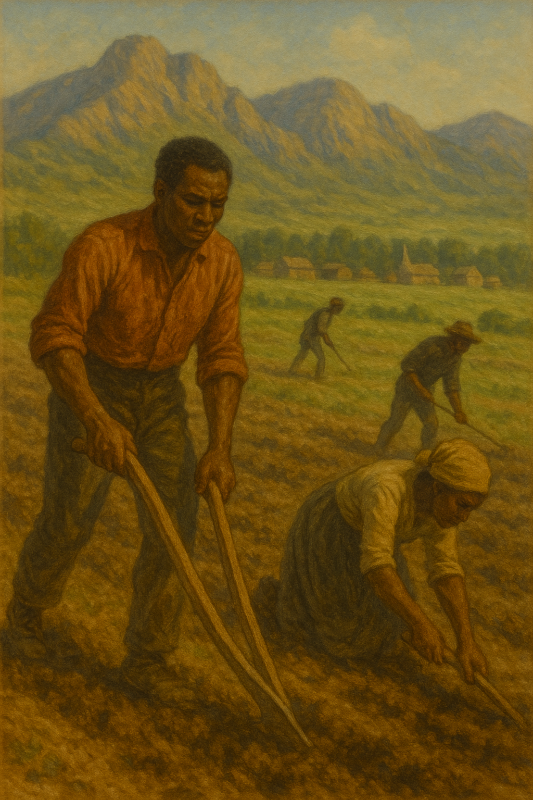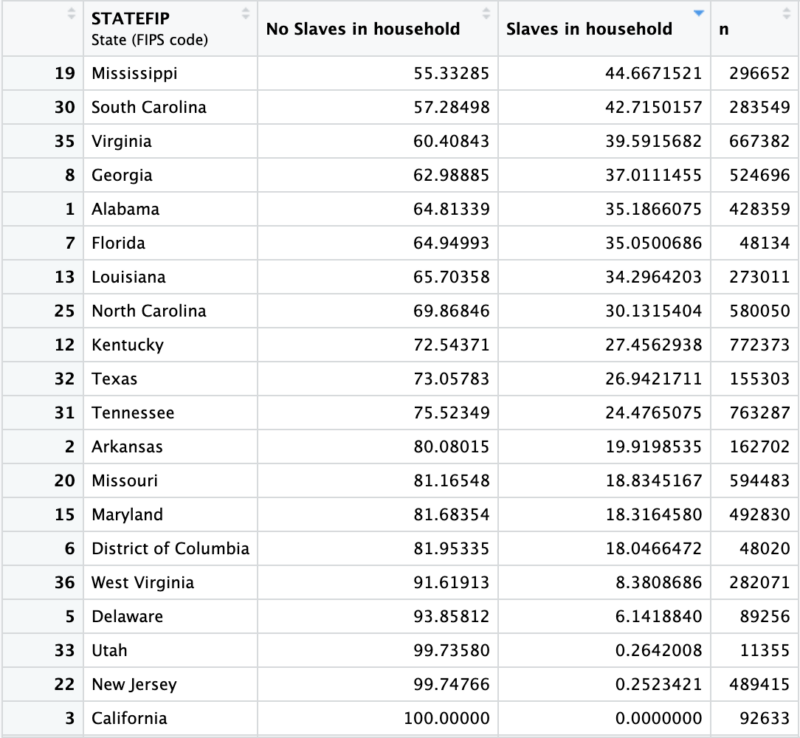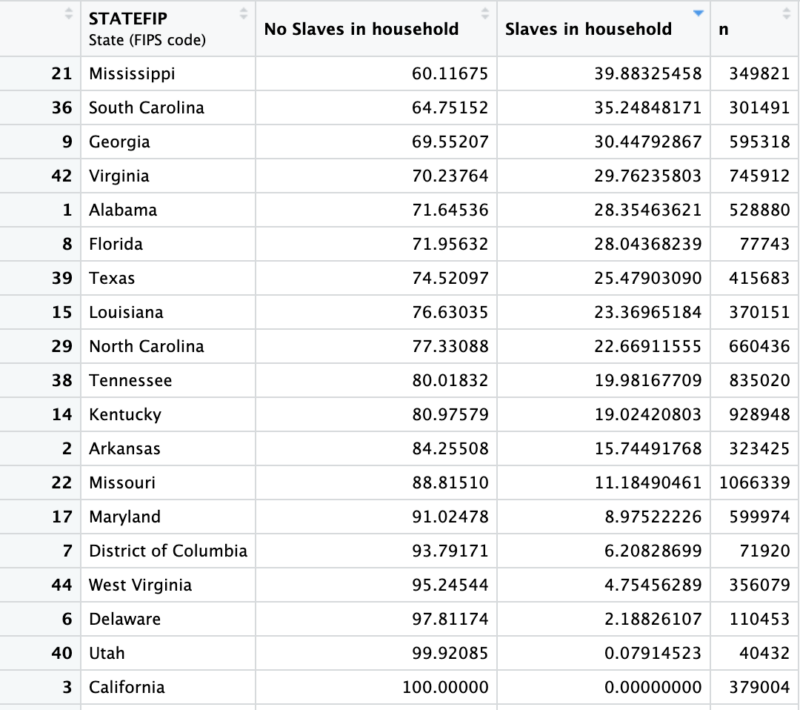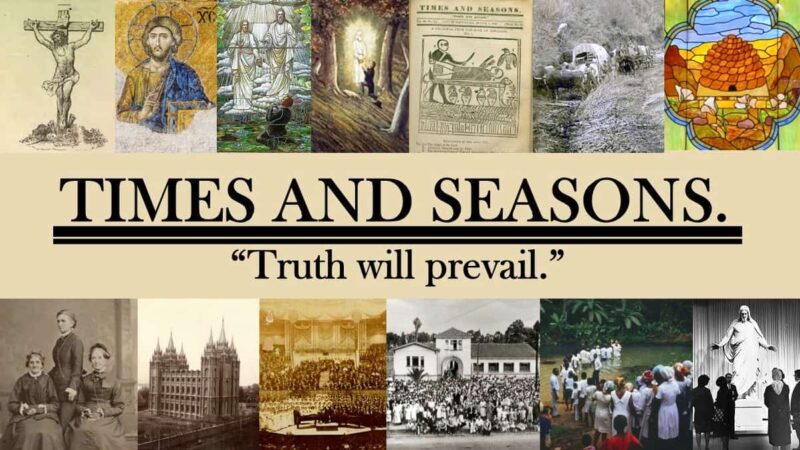
It’s a black mark on our history that early Utah allowed slavery. Other people more informed than I have more detail on the people involved and legal details (This Abominable Slavery is on my to-read list, but I haven’t gotten to it yet), but I was curious about where Utah stood relative to other states. In 1850 and 1860 the US Census asked households whether they had any slaves, so I ran a weighted crosstab on % households with slaves.
In 1850 the census reported on 37 states. Of those 19 reported some slaves. When we rank order the states by slaveholdings Mississippi was the most slave-holding state, with 45% of households reporting a slave. At the bottom of those with any slaves is Utah and New Jersey, which were both well under 1%.

Others have written about how legally Utah slavery was quite different from Southern chattel slavery, and it looks like both qualitatively and quantitatively slavery in Utah shouldn’t conjure up the same pictures as large-scale plantation slavery. That is not to excuse it in the slightest of course, it is what it is.
When we look at 1860 on the eve of the Civil War the picture is similar.

By 1860, of states that had slavery Utah was the least slave holding state, with 99.9% of households not owning slaves. (Interestingly, the next least slave-holding state, Delaware was the last state to ban slavery and not, contrary to popular mythology, Texas). Again, this isn’t to excuse this black mark in slightest, but it’s interesting to see the cross-state variations and context.
Credit to the amazing folks at IPUMS for making historical decennial census data easily available.
Code:
library(pollster)
if (!require(“ipumsr”)) stop(“Reading IPUMS data into R requires the ipumsr package. It can be installed using the following command: install.packages(‘ipumsr’)”)
ddi <- read_ipums_ddi(“Location/usa_00024.xml”)
data <- read_ipums_micro(ddi)
data_1850<-subset(data, YEAR==1850)
X_1850<-crosstab(data_1850, STATEFIP, SLAVEHH, HHWT)
data_1860<-subset(data, YEAR==1860)
X_1860<-crosstab(data_1860, STATEFIP, SLAVEHH, HHWT)

Comments
14 responses to “How Many Slaves Were in Utah Compared to Other States?”
It’s a technicality, but Utah wasn’t a state until 1896.
Also, West Virginia was part of Virginia at this time. Do the numbers for Virginia include the part of the state that later became West Virginia? By my math, even if California had only one slave-holding household among 379,004, that should be 0.000264%. If the number were zero as listed, then why would California be included in the table among the states (also territories, future states, and federal districts) reporting enslaved persons?
It looks like they did retroactive geographic harmonization for territories: https://usa.ipums.org/usa/slave/vars/statefip_desc.shtml
If slavery (or servitude or whatever) was legal in Utah, why was the actual practice so small?
Regional origin? Mormon doctrine? Something else?
This count appears to exclude enslaved Native Americans. Wikipedia sources state there were at least 400 enslaved “indians” from 1850 through 1865 and likely a lot more than that due to under-reporting. Do these numbers only include enslaved black people?
Jeremy: Not sure, I think the wording just mentions “slaves” in the household.
Mark Ashurst-McGee: I have my speculations, but I know historians absolutely love it when quants rush in to explain things with zero domain-specific background knowledge or context :)
Mark, I’d argue it was the nature of the converts. Missionaries did much better in the North than the South. One generally needed to be on the wealthy side to own slaves, and there’s a tendency for the wealthier converts to have had a Quaker background like Martin Harris and Edward Hunter. Quakers were very anti-slavery. Missionaries tended not to convert a lot of wealthy southerners. Very successful in England where slavery wasn’t legal.
And as you see, this doesn’t list the free northern states that outlawed slavery. The North and England is where most of the converts came from. Thus culturally, Utah was essentially a free state that happened to allow slavery. Mormons did pretty good in New Jersey too.
You really should read “This Abominable Slavery.” A lot of the issues here and in the comments are covered in it. Very solid history, very well done.
A couple of relevant excerpts:
“Since the famous Somerset case of 1772, it had been widely believed in both England and America that common law did not recognize the institution of chattel slavery. Rather, slavery required the sanction of positive law, that is, some kind of legislative act. Without a statute, slavery could not legally exist within a given jurisdiction. No such regulations existed in Deseret, and Young had made it clear that none would be forthcoming. In other words, the highest-ranking members of the Mormon hierarchy were communicating their belief that Deseret was legally free soil and would remain so without the need for any statutory or constitutional provision to that effect.” (65)
“Many Latter-day Saints fully agreed with this proposition, including Brigham Young. [thus] if no one could be held as a slave, it followed that no one should be counted as a slave on the census. But . . . the Utah census ultimately reported some twenty-six slaves and twenty-four free Black people in the territory. It further stated that all the slaves were “on their way to California.” This was both true and misleading. Most of the twenty-six individuals enumerated on the census were in fact members of an expedition that left Utah in March 1851 to build a Mormon colony at San Bernardino, California. But this was an undercount of the actual enslaved population of the territory. In fairness, Utah was not unique in this regard. California did not report a single slave on its 1850 census return, although hundreds of enslaved people were then laboring in the gold fields.” (69-70)
Thanks for the helpful post.
I too recommend “This Abominable Slavery.” Enthusiastically. It dramatically transformed my (previously quite ignorant but definitely uncomfortable) sense of slavery in the Great Basin Kingdom. So much so, in fact, that I’ll be speaking on the subject of “Brigham Young and Slavery” at the annual FAIR conference on 8 August in American Fork — and drawing, umm, slavishly on the book.
OK, so then why was Mormonism so comparatively unappealing to Southerners (or, more specifically, to Southern enslavers)?
I do speculate about that in some of my writing. It’s a bigger topic, but Mormon missionary work starts out in the North and thus gets a head start. Then after the Missouri trouble, missionaries to the South say that the Southerners were generally on the Missourians’ side: good pious slave-holders against crazy Northern fanatics. Whereas Mormon proselytizing probably benefitted in the North over the Missouri persecution.
My work on the success in the middle states (Penn, Del, NJ) does indicate that many there, especially ex Quakers that the Mormon did well among, who really did sympathize with the Mormons over the Missouri persecution. (Lots of ex Quaker converts were above average in wealth but very anti slavery). One of the richest early Mormons, Edward Hunter, said the persecution played a big role in his conversion.
Mormon missionaries said that Southerners generally didn’t feel sympathetic to the Mormons but rather the Missourians.
I do think cultural and religious background had an influence on Mormon proselytizing success. And American regional differences played a part.
To answer Mark’s original question from a different direction: large-scale slavery was all about producing cash crops for export. With no seaports or navigable rivers, until the transcontinental railroad got there Utah was in no position to export anything but the Gospel. And the country couldn’t have nice things like the transcontinental railroad or land grant universities until the Civil War prompted southerners to leave Congress–and then slavery’s time was running out.
“Black mark” I see what you did there lol